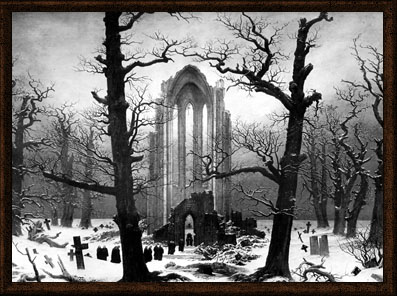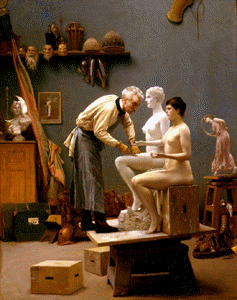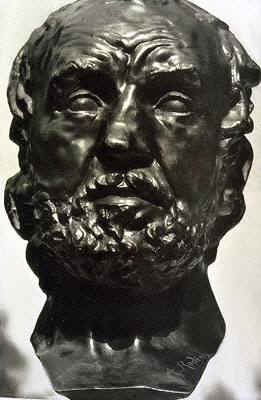H. de Roos - Rodin´s Approach to Art |
|
|
|
|
|
By the beginning of the nineteenth Century, this romantic tendency had found its expression in Art all over Europe, giving room for the subjective, the imaginative, the spontaneous and the visionary. Romantic Art would focus on the emotions and the senses, instead of the intellect; would highlight the exceptional and heroic, the conflict between individual and society and the inner struggle of its protagonists; would idealise the gothic, the medieval, the exotic, the dark and mysterious. And, above all, it would celebrate Nature. Caspar David Friedrich (1774-1840) paints gloomy mountain, forest and sea views, twilight skies hovering over the ruins of a church, the ice-covered wreck of a ship called Esperanza, Hope. The efforts of civilisation appear frail vis-à-vis the elementary powers. |
Monastery Graveyard in the Snow
|
|
Since the 1820´s, the actual balance has shifted.
Economic production leaves the confinement of the workshop, becomes
bundled in the manufacture, then powered by the steam engine. |
|
|
Jean-Léon Gérôme, French, 1824-1904
|
Politically, the disruption caused by the French Revolution and Napoleon´s ambitions is smoothed out, the aristocratic families reign again, sharing their power with bourgeois parties. Between the 1848 upheaval and the 1870 Paris Commune, French Art tends to reflect and affirm this social status quo, as if it were timeless, which - at that time - means classical. The Neo-Classicism of the eighteenth Century is set forth, in architecture, painting and sculpture. Heroes, goddesses, nymphs from ancient mythology, biblical prophets, allegorical virtues populate the paintings. Exhibitions takes place in juried Salons, artistic training is concentrated in prestigious academies - hence the name Academic Art for the style of this époque.And for every occasion, for every statement, there is a pre-approved pose, a fixed list of attributes. There is harmony, the perfect balance of proportions, the straight lines of the Greek profile. Rodin, on the contrary, depicts his model Bibi with a broken nose and asymmetric traits. |
|
Instead of professional models, he hires peasants,
dancers, acrobats, invites them to move freely in his atelier, to surprise
him with their unstudied gestures. Your mind has to understand every surface as the outer limit of a volume pressing against it. Imagine shape as something directed towards you. All life has its origin in a centre, then it blosoms and unfolds outward from within. Exactly this way one can sense a mighty inner impulse in every beautiful sculpture. That is the secret of antique Art.
|
Mask of the Man with the Broken Nose,
|
|
|
|
|
Notice:
Museum logos appear only as buttons linking to Museum Websites and do not
imply any |
|


